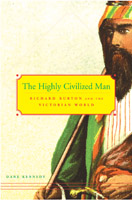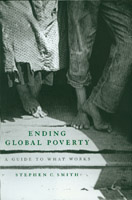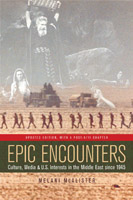|

Extraordinary Perspective
 An
adventurer who secretly entered Mecca and a translator
who brought Arabian Nights to English-speaking
audiences, Richard Burton was a man who seemingly
lived many lives. An explorer, soldier, ethnographer,
poet, and travel writer, Burton helped Victorian
Britain understand new cultures and peoples encountered
during the country’s imperialist march around
the globe. In The Highly Civilized Man: Richard
Burton and the Victorian World (Harvard University
Press, 2005), Dane Kennedy helps readers understand
Richard Burton. An
adventurer who secretly entered Mecca and a translator
who brought Arabian Nights to English-speaking
audiences, Richard Burton was a man who seemingly
lived many lives. An explorer, soldier, ethnographer,
poet, and travel writer, Burton helped Victorian
Britain understand new cultures and peoples encountered
during the country’s imperialist march around
the globe. In The Highly Civilized Man: Richard
Burton and the Victorian World (Harvard University
Press, 2005), Dane Kennedy helps readers understand
Richard Burton.
Kennedy, Elmer Kayser Professor of history and
international affairs, explores different aspects
of Burton’s personality and career in the
book’s eight chapters, which range from
“The Gypsy” to “The Racist”
to “The Afterlife.” Drawing on experiences
gained during his travels and fueled by relentless
curiosity, Burton sought to unlock the secrets
of various cultures and, in turn, questioned the
Victorian way of life.
“Biographers have tended to portray [Burton]
in Nietszchean terms as a heroic, independent
spirit operating outside the bounds of social
conventions,” Kennedy writes. “Yet,
for all his unusual talents and contrarian character,
he was very much a man of his time, a product
of nineteenth-century Britain and its imperial
encounter with the world.”
Kennedy shows how Victorians came to better
understand themselves while viewing other cultures
through Burton’s gaze. This perspective
proves useful to modern readers as well—as
Publisher’s Weekly writes: “Kennedy
succeeds in re-establishing Burton as a relevant
figure for a 21st-century world grappling with
issues of ethnic, cultural, and sexual diversity.”
Conquering World Poverty
 The
numbers are chilling. More than 800 million people
worldwide suffer from chronic hunger. Every day,
some 30,000 children in developing countries die
from preventable causes—almost 11 million
this year alone. Professor of Economics Stephen
C. Smith offers strategies for tackling world
poverty in his new book, Ending Global Poverty:
A Guide to What Works (Palgrave Macmillan,
2005). The
numbers are chilling. More than 800 million people
worldwide suffer from chronic hunger. Every day,
some 30,000 children in developing countries die
from preventable causes—almost 11 million
this year alone. Professor of Economics Stephen
C. Smith offers strategies for tackling world
poverty in his new book, Ending Global Poverty:
A Guide to What Works (Palgrave Macmillan,
2005).
Smith, who directs GW’s Research Program
in Poverty, Development, and Globalization, explores
the myriad traps that keep people entrenched in
poverty—such as malnutrition, illiteracy,
and poor access to health care—and presents
eight keys to escaping those traps. These “keys
to capability”—ranging from basic
education, which builds the foundations for self-reliance,
to personal and community empowerment, aimed at
ensuring effective participation in the wider
world, help people gain the tools to break out
of the bondage of extreme poverty.
The book also offers comprehensive strategies
for building capabilities and assets among the
impoverished and provides an extensive set of
anti-poverty initiatives and programs aimed at
conquering human poverty in a single generation.
Smith is co-author, with Michael Todaro, of
a leading text in the field, Economic Development
(8th Ed., Addison-Wesley/Pearson, 2002), and has
done on-site work in a number of developing countries,
including Bangladesh, Ecuador, Egypt, Kenya, India,
Peru, and Uganda. He has taught courses on economic
development with an emphasis on problems of poverty
since 1983.
Conflict Culture
 From
news reports to Web logs, popular culture plays
a part in how Americans view conflict and diplomacy
with the Middle East. In Epic Encounters:
Culture, Media, and U.S. Interests in the Middle
East Since 1945 (revised edition, University
of California Press, 2005), Melani McAlister asserts
that U.S. foreign policy—while grounded
in economic and military issues—is developed
in cultural context. Religious beliefs, media
coverage, and popular culture contribute to how
Americans understand the Middle East. From
news reports to Web logs, popular culture plays
a part in how Americans view conflict and diplomacy
with the Middle East. In Epic Encounters:
Culture, Media, and U.S. Interests in the Middle
East Since 1945 (revised edition, University
of California Press, 2005), Melani McAlister asserts
that U.S. foreign policy—while grounded
in economic and military issues—is developed
in cultural context. Religious beliefs, media
coverage, and popular culture contribute to how
Americans understand the Middle East.
McAlister, associate professor of American studies
and international affairs, illustrates this phenomenon
in her chapter “9/11 and After: Snapshots
on the Road to Empire,” in which she analyzes
five images that have shaped global consciousness
since Sept. 11, 2001: New York City firefighters
raising the American flag from the rubble of the
World Trade Center; Osama bin Laden’s televised
image; Afghan women in burqas; Saddam Hussein’s
statue toppled in Baghdad; and a hooded prisoner
in Abu Ghraib. McAlister explores the contexts
of these images both at the time they were taken
and as they relate to current events.
While the Middle East has been a focal point
of the American government, military, and public
for decades, recent events have thrust the region
even further into the limelight. “Any attempt
to reckon with the world after September 11 is
necessarily constrained by the force of current
events: We are looking backward at something that
is still rushing ahead,” McAlister writes.
By making sense of how Americans view the Middle
East, McAlister also illustrates how Americans
view themselves. “McAlister is uniquely
placed to reveal what she calls ‘the often
invisible significance of the Middle East to Americans,”
writes The Village Voice. “[McAlister]
reconfigures American investment in the Middle
East as a central element to our own national,
racial, and sexual identities.”
—Laura Ewald and JLF
|